Abstract
Diptera-borne diseases pose a major threat to global health, and their distribution is constantly changing due to climate change, globalization, and environmental changes. To improve the knowledge of dipteran species and their distribution in equine facilities, CDC-UV and oviposition traps were placed, and the dipping technique was performed in 16 equestrian centers of Northwest (NW) Spain (Galicia and Castilla y León Autonomous Communities) between July and November 2023. A questionnaire was distributed among the horse owners to obtain additional information. Four genera of culicids, Culex (51.8%), Culiseta (38.6%), Anopheles (8.4%), and Aedes/Ochlerotatus (1.2%) were identified in the equestrian centers. Culex pipiens s.l. was the most prevalent and well-distributed species (93.8% of the centers), whereas Anopheles maculipennis s.l. and An. claviger/petragnani, the anopheline species, were the most frequent (37.5% and 31.2%, respectively). The Culiseta genus was found in approximately 81.2% of the equine facilities. All genera were collected at medium and high altitudes and in Csb (warm-summer Mediterranean climate) areas. Equestrian centers from NW Spain albeit a variety of culicids with high vectorial capacity, together with an ideal environment for their breeding, the presence of vectors and hosts (humans and animals). This potential problem for global health enhances the need for entomological surveillance.
1. Introduction
Order Diptera-borne pathogens and their diseases affect more than 300 million people all over the world [1] every year. There are up to 100 pathogens that can be transmitted by female mosquitoes due to their hematophagy behavior, but most of them are limited to tropical and subtropical climates where these vectors are found [2]. In Europe, several species of culicids are widely known for their role in the transmission of different diseases, many of which are endemic in at least one country [3].
The appearance and expansion of vector-borne diseases are due to multifactorial causes, mainly those related to the imbalance of ecosystems and the interaction of pathogens, vectors, and hosts [4,5]. Different countries are registering some changes in climate, mainly involving an incremental increase in temperature [6]. This seems to be related to the fact that, in recent years, new invasive species belonging to the genus Aedes (i.e., Ae. albopictus, Ae. aegypti, Ae. japonicus, Ae. atropalpus, and Ae. koreicus) have been detected, capable of establishing their colonies in certain regions that were previously free of these species [7,8,9].
Spain is considered a country of potential risk for the entry of invasive mosquito species, as well as for the entry and establishment of different emerging pathogens transmitted by them [10,11,12]. At present, Galicia in Northwestern (NW) Spain is not considered an endemic region for any mosquito-borne diseases, but the presence of the three genera from the family Culicidae (i.e., Culex, Anopheles, and Aedes), which may pose a risk to public health, has been described [13]. In particular, several species that can act as vectors of zoonotic pathogens have been identified, such as Culex pipiens, Culex theileri, Aedes vexans, and Aedes caspius [14].
An effective surveillance system for human and animal diseases is essential for early detection and rapid response, as well as for prevention and control programs, while allowing for the effectiveness of implemented strategies to be assessed. In this context, it appears essential to obtain information about the dipteran species that might affect certain animal species of particular interest to people, for the purpose of assessing the risk of some diseases that might spread to humans as well (Figure 1). Under this approach, surveillance of facilities containing animals can offer very useful information regarding the potential risk of certain vector-borne diseases. The wide variety of species involved and the often complex natural history of zoonotic agents present a real challenge [15]. This way, the identification of potential risks to public and animal health, as well as the development of control and prevention programs, requires knowledge of the species present in each region in addition to ecological and wildlife studies in reservoirs or vectors [16].
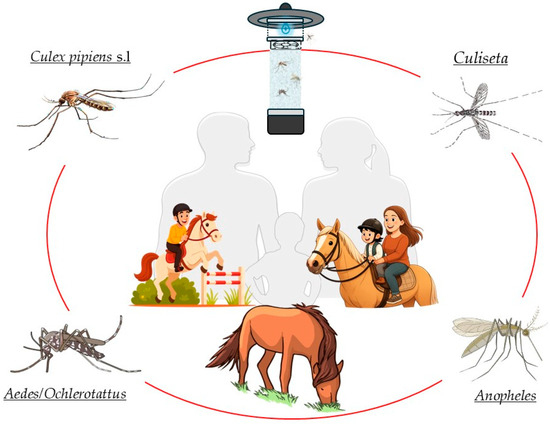
Figure 1.
The prevention of Diptera-borne diseases requires surveillance, including those places where people enjoy animals.
The usefulness of animals as sentinels to monitor certain mosquito-borne zoonoses has been previously stated [11]. In the present study, the value of the surveillance of the main dipteran species in equestrian centers in NW Spain was conducted to assess the risk of possible zoonoses that could be transmitted.
2. Materials and Methods
2.1. Area of Study
Between July and November 2023, a total of 16 equestrian centers and stud farms in NW Spain were sampled by placing different trapping devices (Figure 2).
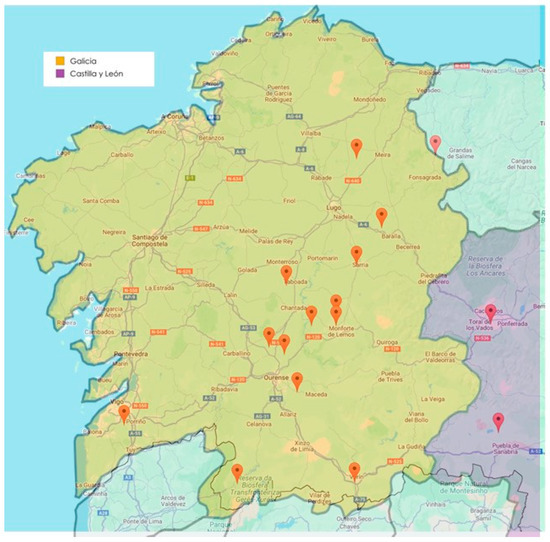
Figure 2.
Locations of equine centers involved in the current study. Map created with EZ Maps and MapChart.
The owners were contacted by phone and all accepted to participate, with the agreement to send them a brief report including the results. The area of the study comprised two autonomous communities, Galicia and Castilla y León. To establish the climatic areas of these regions, the Köppen-Geiger classification was contemplated; hence, two climatic areas usually occurring on the western side of the continent between the latitudes of 30° and 45° were considered [17]:
- −
- Csb or warm-summer Mediterranean climate: characterized by the coldest month averaging above 0 °C, all months with average temperatures below 22 °C, and at least four months averaging above 10 °C.
- −
- Csa or hot-summer Mediterranean climate: Summers are dry and hot, with at least 22 °C averaged across the night–day cycle. The average temperature of the coldest month is <18 °C but above −3 °C. The wettest winter month has about 3 times as much precipitation compared to the driest summer month.
The altitude where the equine centers are located was also considered, then four classes were established according to prior investigations [18]:
- −
- Low: below 300 m above sea level (asl). → → High: between 501 and 1000 m asl.
- −
- Medium: between 301 and 500 m asl. → → Elevated: Above 1000 m asl.
2.2. Collection of Diptera
A total of 77 samplings were conducted, involving 63 with CDC-UV (ultraviolet) traps, two oviposition traps, and 12 dipping. One miniature downdraft blacklight (UV) trap Model 512 (Entomopraxis®, Barcelona, Spain) (Figure 3), which allows for the capture of adult dipterans, was placed in each center close to the animals at 1.7 m above ground and left running continuously from dusk until the following morning (12 h approximately).
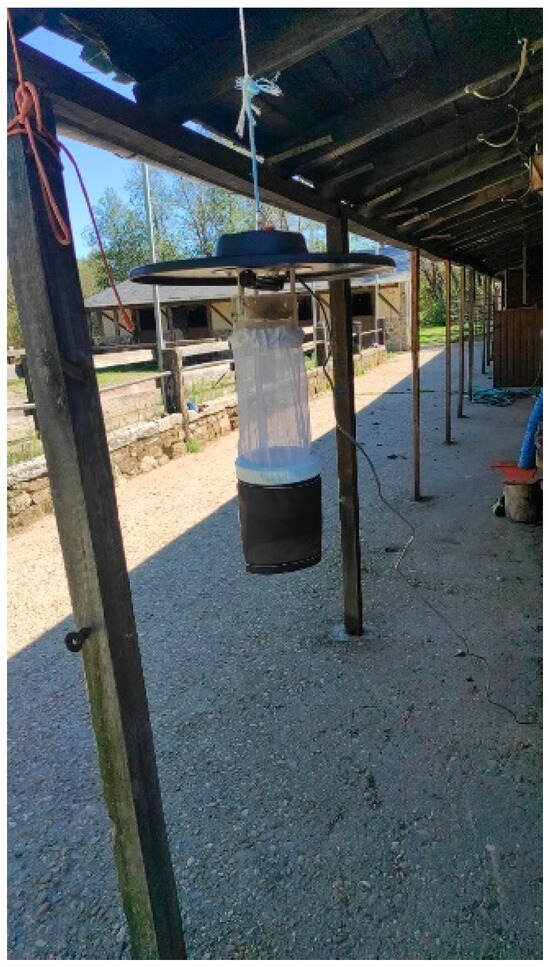
Figure 3.
CDC-UV traps placed in equestrian centers to capture dipterans.
The collection tanks were transferred to the COPAR Laboratory (Faculty of Veterinary Medicine of Lugo, University of Santiago de Compostela, Spain) and frozen at −20 °C. Later, the identification was performed under a stereomicroscope (Leica EZ4D, Wetzlar, Germany), by using taxonomic and interactive keys [19,20,21].
Oviposition traps (Entomopraxis®, Barcelona, Spain), consisting of a black plastic pot filled with 500 mL of tap water and a small piece of wood leaning on the walls of the container, were left for 15 days in previously chosen locations because of their suitable conditions for culicid breeding (shadowed places). After this period of time, their contents were collected in stagnant polyethylene jars and taken to the same laboratory, where the fourth-stage larvae or even adults were identified, using a taxonomic key [19].
The dipping technique, an active sampling method that enables the capture of larvae, was carried out in the areas of stagnant water, drinkers, barrels, and tires that were close to the animals or facilities, since those are the breeding areas for culicids. Stagnant water (500 mL) was collected with polyethylene wide-mouth jars (Figure 4) at each sampling and later analyzed in the COPAR laboratory, looking for culicid larvae.
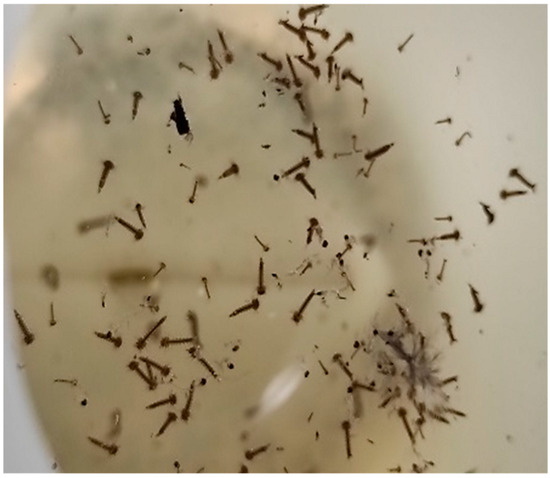
Figure 4.
Dipteran larvae collected by oviposition traps.
2.3. Questionnaire
A brief questionnaire was distributed among the owners of the equestrian centers to obtain information on the main points related to the possible presence of dipterans regarding the characteristics of each equine facility, horse management, or insect control measures. Fourteen questions were asked and several answers were possible: number of animals housed, frequency of people present in the facilities, other animal species nearby, distance (km) to farms, houses and forest, stabling regime, grazing possibilities, traveling animals, presence of drinkers in the boxes, presence of manure near to boxes, presence of Diptera during winter, horse allergies to mosquitoes, and insect control measures (Figure 5).
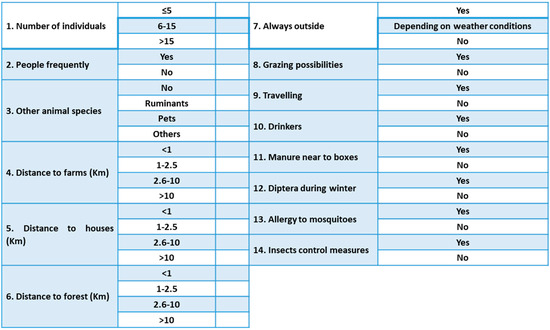
Figure 5.
A survey distributed among horse owners to gather information about the main points related to the possible presence of dipterans.
2.4. Data Analysis
Data collected were analyzed based on the answers to the survey (Figure 5) and the climatic areas where the equine centers were localized.
Because of data collected in the present investigation were not normally distributed (Kolmogorov–Smirnov test, p < 0.05), then the non-parametric Kruskal–Wallis test was applied to compare medians between more two groups or more than two groups, respectively, by using the IBM SPSS statistical package v. 22.0 (Chicago, IL, 139 USA). Significance was considered at p < 0.05.
3. Results
3.1. Specimens Identified
Of a total of 77 samples, 57 were positive (74%). A total of 48/63 (76.2%) captures made with CDC-UV traps and 9/12 (75%) dipping performed were positive, while both oviposition traps remained negative. The specimens collected belonged to the families Culicidae and Ceratopogonidae. Of the Culicidae family, 334 specimens were classified as belonging to genera Anopheles (n = 28), Culex (n = 173), Culiseta (n = 129), and Aedes/Ochlerotatus (n = 4) (Table 1); a total of 282 (84.43%) specimens were collected by CDC-UV traps and 52 (15.57%) by dipping technique.

Table 1.
Dipteran specimens collected in equestrian centers.
Genus Culex was the predominant one, representing 51.8% of the captures, with three different species identified: Cx. pipiens s.l. (58.9% of the genus and 30.5% of the total captures), Cx. theileri (9.8% of the genus and 5.1% of the total), and Cx. perexiguus/univitattus (with less than 1% within the genus since a single specimen was found throughout the entire study). The remaining 30.6% of specimens belonging to this genus could not be identified due to the loss of body parts and/or morphological characteristics. The second most abundant genus was Culiseta (38.6%), with Cs. annulata (67.4% of the genus and 26% of the total) and Cs. longiareolata (32.6% of the genus and 12.6% of the total).
From the 28 specimens (8.4%) of the genus Anopheles captured, 50% were identified as An. maculipennis s.l. (4.2% of the total captures), being the most abundant species of this genus; 25% as belonging to the complex An. claviger/petragnani (2.1% of the total); and 0.6% as An. plumbeus, with only two specimens. As with some Culex specimens, five anophelines (17.9% of all anophelines) could not be identified at the species level due to the poor condition of the specimens when the collection buckets were emptied.
Finally, as far as the family Culicidae is concerned, three adult specimens of Ae. vexans and one of Ochlerotatus leucomelas were identified.
Of the genus Culicoides, two species were identified, C. obsoletus and C. punctatus, although the exact numbers of specimens were not registered.
3.2. Results by Centers
The presence of culicids of interest to public health was confirmed in 15 of the 16 (93.75%) equestrian centers participating in this study (Table 2).

Table 2.
The distribution of diptera captured according to the equestrian center and type of climate.
The species Cx. pipiens were the most prevalent and well distributed, being identified in 93.75% (15/16) of the centers; Cx. theileri was identified in 56.25% (9/16) centers; and Cx. perexiguus/univitattus was identified in just one of them (6.25%) (Table 3).

Table 3.
Prevalence (%) of dipteran species captured in equestrian centers.
Concerning the genus Anopheles, An. maculipennis and An. claviger/petragnani were the species with the greatest frequency, being present in 37.5% (6/16) and 31.25% of the centers, respectively. Finally, An. plumbeus was only identified in one out of the 16 (6. 25%) of the centers.
The genus Aedes/Ochlerotatus was identified in only two (12.5%) equestrian centers. One specimen of Ae. vexans was captured in both centers, while Oc. leucomelas specimens were identified in just one of them.
The genus Culiseta was present in 13 of 16 (81.25%) centers, and two species were identified: Cs. annulata in 7/16 (43.75%) and Cs. longiareolata in 6/16 (37.5%).
By considering the simultaneous collection of different genera or species, more than two genera of culicids were identified in 50% (8/16) of the equestrian centers, with the combination of Culex and Anopheles being the most common. In 12.5% (2/16) of the centers, two species of the same genus were identified, Cx. pipiens and Cx. theileri, and only in one center, the three genera, Culex, Anopheles, and Aedes, were detected. On the remaining horse farms, in 25% (4/16) only, Cx. pipiens was identified.
In addition, the presence of the family Ceratopogonidae was confirmed in 5/16 (31.25%) equestrian centers by the identification of C. obsoletus and C. punctatus.
3.3. Climatic Areas
According to the climatic areas, 62.5% (10/16) of the equine centers are located in Csb zones and 37.5% in Csa (Table 4).

Table 4.
Diptera genera identified according to the climatic areas and altitude where the equestrian centers are located.
All four culicid genera, Anopheles, Culex, Aedes/Ochlerotatus, and Culiseta, were identified during our study in Csb climatic areas, while Aedes/Ochlerotatus was not collected in the Csa zones. The number of Anopheles specimens was significantly higher in Csb regions, and Culex in Csa. No statistical significance for Aedes/Ochlerotatus or Culiseta. Although Culicoides specimens were identified in both Csb and Csa climatic regions, no statistical association was found.
Regarding the altitude of the equestrian centers’ locations, all dipteran families and genera identified in this study were present at medium and high altitudes (301–1000 m asl) (Table 4), and only Aedes/Ochlerotatus was absent at lower and elevated altitudes.
3.4. Survey Data
As summarized in Table 5, most of the equine centers visited had more than six horses. Despite the fact that the highest prevalences were observed in those centers with 6–15 individuals, statistically significant differences were not obtained (p > 0.05).

Table 5.
Risk factors for the presence of diptera in equestrian centers according to owners’ responses to the questionnaire.
Almost half of the centers are dedicated to activities that include teaching horse riding or horseback riding on country trails and in forests, so people are present nearly every day. The highest prevalence values of the genera Anopheles, Culex, Culiseta, and Culicoides were recorded in these centers with people, but significant differences were demonstrated only for Anopheles (χ2 = 6.125, p = 0.013) and Culiseta (χ2 = 5.657, p = 0.017) (Table 5).
No differences were observed according to the presence of other animal species, such as pets (dogs and cats). Although most of the centers were 1–10 km away from livestock farms (Table 5), significant differences were not recorded. Most of the equine centers were located within a 2.5 km distance to housing or forested areas, but no statistically significant differences were found.
Concerning the keeping conditions, half of the centers always kept the horses outside where they can graze during the day, and despite the highest prevalence values of Diptera being achieved in these centers, no significant influence was observed (Table 5). A similar pattern was obtained for those centers where horses travel regularly to participate in meetings, horse races, and other competitions, but significant differences for Culex were obtained (χ2 = 4.468, p = 0.031).
In most equine centers, there are automated horse waterers, and the presence of Anopheles was significantly lower in these facilities (Table 5). In half of the centers where manure was stored next to the buildings (0–5 m), the highest prevalence of Diptera was found (p > 0.05) (Figure 6).
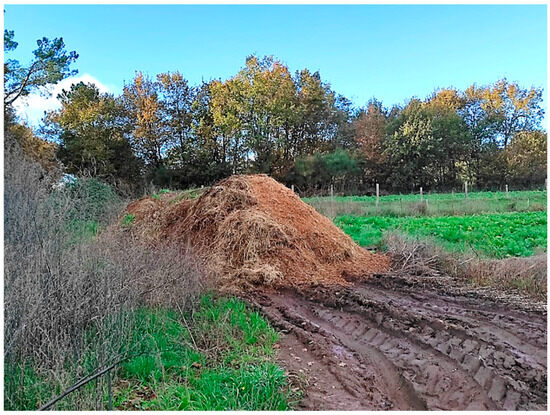
Figure 6.
Piles of manure stored close to the facilities.
The presence of Diptera during winter was detected in 37.5% of the centers. Horse allergies to mosquitoes were reported in 31.25% of the centers, and significant differences were demonstrated in the prevalence of Culiseta (χ2 = 5.303, p = 0.021) (Table 5). Finally, only two equine centers applied some measures for the control of insects, consisting of fly repellents and Asian hornet (Vespa velutina) traps.
4. Discussion
The surveillance of dipterans in equestrian centers from NW Spain revealed the presence of culicid genera in all of them, and except for one, the existence of species of sanitary interest due to their role as vectors of various diseases was confirmed. The predominant genus was Culex, the most abundant and widely distributed in Galicia [13]. The species Cx. pipiens s.l. was the most frequent, in agreement with previous investigations conducted in the same area [14,22,23] and on equine farms in other European areas, such as Belgium [24]. Based on its high ability to adapt to different habitats and little specificity for its hosts, several generations can occur per year [25]. The importance of Cx. pipiens s.l. lies in its great vectorial capacity for various zoonotic pathogens, playing an important role in the transmission of different arboviruses (e.g., West Nile virus and Usutu virus), as well as the parasitic nematode Dirofilaria immitis; therefore, it has acquired great relevance in public and animal health [26]. Two other genera of culicids with importance for public health have also been detected, such as Anopheles and Aedes/Ochlerotatus.
In the current study, three species/complexes belonging to the genus Anopheles were identified, An. maculipennis s.l., An. Plumbeus, and An. claviger/petragnani. This genus is widely distributed in the Iberian Peninsula and has a preference for natural areas with abundant vegetation, near permanent natural water bodies rich in organic matter [14], conditions which were frequently observed in the current study. Although the presence of Anopheles was significantly higher in Csb climatic areas (warm-summer Mediterranean), it was also identified in Csa (hot-summer Mediterranean) zones. These results highlight that this genus has a wide distribution in Galicia. Regarding the genus Aedes, two specimens of Ae. vexans were identified in Csb areas, a situation which agrees with previous descriptions [27]. The genus Culiseta was widely distributed among the equestrian centers, thus confirming their huge circulation in Galicia [28]. Culiseta longiareolata can be a vector of avian paludism but has no implications for public health, while Cs. annulata is involved in the transmission of Tahyna virus to humans, avian paludism, and rabbit myxomatosis [29]. The family Ceratopogonidae was detected in almost one-third of the centers in both Csb and Csa climatic areas, also confirming prior findings [13,27,28]. This genus has great importance for animal health since its representatives are vectors of serious animal diseases as Bluetongue and epizootic hemorrhagic disease, affecting domestic and wild ruminants [30], and African horse sickness (AHS), which, despite not being present in Europe, has been responsible for major outbreaks originated by the introduction of reservoirs from endemic areas (Africa) in various European countries, including Spain. Furthermore, due to its high lethality and the severity of the clinical conditions that occur in horses, AHS is a disease [31].
Results presented here, where ten species of culicids were identified, underline the important diversity of dipteran species, which might act as vectors of several pathogens, in equestrian centers from NW Spain. Other associated issues include disturbances to people and animals being bitten by them, a circumstance which frequently results in a substantial local inflammatory response [32]. The lack of differences in the presence of dipterans regarding the horses’ keeping conditions, especially during their continuous maintenance under field conditions, appears to indicate that dipterans are attracted to stables or boxes, which might explain why a little more than one-third of horse owners observed them during winter. Breeding areas are different for both dipteran families. While culicids are strictly aquatic and lay their eggs in natural or artificial stagnant waters found near hosts, Culicoides require organic matter and humidity, such as feces or manure stored near animals [33]. In the same way, no influence was recorded on the distance between the horse centers and the localization of houses or forested zones, a fact that reflects the wide distribution of dipterans in the study area.
Diptera-borne pathogens and the diseases they cause are emerging and re-emerging in Europe, mainly due to climate change, globalization, and environmental changes, natural or artificial, and many of them are zoonotic in nature with a great impact on public health [4,9]. At the same time, these diseases are mostly influenced by climate change since these vectors are highly dependent on the ecology of the environment, and so the weather conditions will determine the presence and distribution of mosquitoes [34]. The presence of vector-borne diseases will always depend on the coexistence of suitable hosts, vectors, and pathogens [35]. As with other entertainment facilities, equine centers provide considerable benefits for people to enjoy nature, relaxation, or walks. These facilities can also ensure the conditions to enhance the presence of different genera of culicids with great vectorial capacity, as demonstrated in more than half of the equine centers in the present investigation. In addition to this, it looks very conceivable that the constant presence of animals (horses) and humans (horse riders in some cases) provides an ideal environment for maintaining the cycle of different species of hematophagous dipterans as they can serve as potential hosts for the blood meal intake [24,36]. The several species found in this study agree with previous findings in the same area [13,14,27,37].
There is a limited number of zoonoses that can be transmitted between horses and humans under natural circumstances, i.e., Hendra virus, USUTV, or WNV [38], any of which have been reported in Galicia. Although many Diptera-borne zoonotic agents are not yet endemic or established in Europe, such as Dengue, Zyka, Eastern Equine Encephalitis or Saint Louis Encephalitis, it should be emphasized that some equestrian centers house individuals that travel outside the region (250–800 km southward), where they meet other horses of different origins, which may, therefore, pose a risk of exposure to pathogens unidentified in their region or country of origin, thus acting as a gateway to a new territory [15]. Eventually, if a pathogen is introduced, all the conditions are met for its circulation to be established and the disease to appear. In this case, periodical analyses of exposure to certain pathogens seem very useful among traveling horses to avoid the spread and thus, are strongly recommended.
Finally, it is interesting to note that the equine centers in the present research were located in two autonomous communities (Galicia and Castilla-León), with different organizations for the surveillance of diseases, which could make it difficult to apply proper measures for the control of dipterans.
This preliminary study provides very interesting and practical information about the presence of dipterans in equine facilities. More efforts are required to confirm the dipteran species and the possibilities of mosquito-borne diseases, which will cause a great impact on public and veterinary health. To this end, it would be of great interest to extend the sampling season throughout the year to establish its phenology and, also, to extend it geographically to cover the entire community of Galicia.
5. Conclusions
Equestrian centers provide suitable conditions for dipteran survival and multiplication, making them proper locations for their surveillance as their presence was confirmed in 93.75% of the sampled equestrian centers. Since some dipterans may be involved in the transmission of numerous diseases, including certain zoonoses, their monitoring is strongly advised. Further studies are in progress to determine the possibility that some species of dipterans may survive overwintering indoors (boxes).
Author Contributions
Conceptualization: A.P.-S., R.S.-A. and C.C.-M.; data curation: A.P.-S., C.C.-M. and L.C.; formal analysis: C.C.-M., M.S.A. and L.C.; funding acquisition: A.P.-S., R.S.-A. and M.S.A.; investigation: A.P.-S., I.A., D.B. and M.C.; methodology: C.C.-M., M.C. and J.Á.H.; validation: L.C., J.S., I.A. and D.B.; visualization: J.Á.H., I.A., D.B., M.C. and J.S.; writing—original draft: C.C.-M., R.S.-A. and M.S.A., and J.Á.H.; writing—review and editing: A.P.-S., C.C.-M., R.S.-A. and L.C. All authors have read and agreed to the published version of the manuscript.
Funding
This research was funded by the contracts 2025-CP017 and 2025-CP063, between USC (COPAR Research Group) and Deputación Provincial de Lugo (Área de Rural, Vicepresidencia) (Spain).
Institutional Review Board Statement
Not applicable.
Informed Consent Statement
Not applicable.
Data Availability Statement
Data presented in this study are available upon request from the corresponding author.
Acknowledgments
We thank the Head of the Gayoso-Castro Farm (Castro Ribeiras de Lea,—Deputación Provincial de Lugo, Spain) for her valuable collaboration.
Conflicts of Interest
The authors declare no conflicts of interest. The funders had no role in the design of the study; in the collection, analyses, or interpretation of data; in the writing of the manuscript; or in the decision to publish the results.
Abbreviations
The following abbreviations are used in this manuscript:
| An. | Anopheles |
| Ae. | Aedes |
| C. | Culicoides |
| CDC-UV | Center for Diseases Control and Prevention-Ultraviolet Traps |
| Cs. | Culiseta |
| Cx. | Culex |
| Oc. | Ochlerotatus |
| Km | Kilometers |
| NW | Northwest |
| UV | Ultraviolet |
References
- WHO (World Health Organization). Vector-Borne Diseases. Factsheet. Available online: https://www.who.int/news-room/fact-sheets/detail/vector-borne-diseases (accessed on 21 February 2024).
- Foster, W.A.; Walker, E.D. Mosquitoes (Culicidae). In Medical and Veterinary Entomology, 3rd ed.; Mullen, G.R., Durden, L.A., Eds.; Academic Press: Cambridge, MA, USA, 2018; pp. 261–325. [Google Scholar] [CrossRef]
- Medlock, J.M.; Hansford, K.M.; Versteirt, V.; Cull, B.; Kampen, H.; Fontenille, D.; Hendrickx, G.; Zeller, H.; Van Bortel, W.; Schaffner, F. An entomological review of invasive mosquitoes in Europe. Bull. Ent. Res. 2015, 105, 637–663. [Google Scholar] [CrossRef] [PubMed]
- Geier, M.; Rose, A.; Grunewald, J.; Jones, O. New mosquito traps improve the monitoring of disease vectors. Int. Pest Control 2006, 48, 124–126. [Google Scholar]
- ECDC (European Centre for Disease Prevention and Control). Epidemiological Update: West Nile Virus Transmission Season in Europe. 2023. Available online: https://www.ecdc.europa.eu/en/news-events/epidemiological-update-west-nile-virus-transmission-season-europe-2023-0 (accessed on 4 March 2024).
- Copernicus ECMWF (European Centre for Medium-Range Weather Forecasts). 2020 Warmest Year on Record for Europe; Globally, 2020 Ties with 2016 for Warmest Year Recorded. Available online: https://climate.copernicus.eu/copernicus-2020-warmest-year-record-europe-globally-2020-ties-2016-warmest-year-recorded (accessed on 28 April 2021).
- Cevidanes, A.; Goiri, F.; Barandika, J.F.; Vázquez, P.; Goikolea, J.; Zuazo, A.; Etxarri, N.; Ocio, G.; García-Pérez, A.L. Invasive Aedes mosquitoes in an urban–peri-urban gradient in northern Spain: Evidence of the wide distribution of Aedes japonicus. Parasites Vectors 2023, 16, 234. [Google Scholar] [CrossRef] [PubMed]
- ECDC (European Centre for Disease Prevention and Control). Mosquito Maps. Surveillance for Invasive Mosquitoes. 2023. Available online: https://www.ecdc.europa.eu/en/disease-vectors/surveillance-and-disease-data/mosquito-maps (accessed on 26 February 2024).
- Lühken, R.; Brattig, N.; Becker, N. Introduction of invasive mosquito species into Europe and prospects for arbovirus transmission and vector control in an era of globalization. Infect. Dis. Poverty 2023, 12, 109. [Google Scholar] [CrossRef]
- Portillo, A.; Ruiz-Arrondo, I.; Oteo, J.A. Arthropods as vectors of transmissible diseases in Spain. Med. Clin. 2018, 151, 450–459. [Google Scholar] [CrossRef]
- Caballero-Gómez, J.; Cano-Terriza, D.; Lecollinet, S.; Carbonell, M.D.; Martínez-Valverde, R.; Martínez-Nevado, E.; García-Párraga, D.; Lowensky, S.; García-Bocanegra, I. Evidence of exposure to zoonotic flaviviruses in zoo mammals in Spain and their potential role as sentinel species. Vet. Microbiol. 2020, 247, 108763. [Google Scholar] [CrossRef]
- Laycock, T.; Ureña-Paniego, C.; Javier, J. The threat of mosquito-borne arboviral disease in Spain: A bibliographic review. Med. Clin. 2022, 158, 378–386. [Google Scholar] [CrossRef]
- Silva, M.I.T. Epidemiología de Dípteros Que Actúan Como Vectores de Zoonosis en Galicia. Diseño de Una Red de Vigilancia de Vectores. Ph.D. Thesis, Universidade de Santiago de Compostela, Lugo, Spain, 2021. Available online: https://investigacion.usc.gal/documentos/61933e346a8ab2204173b873?lang=es (accessed on 3 November 2024). (In Spanish).
- Polina, A.; Pereira, J.M.; Martínez-Barciela, Y.; Pousa, A.; Íñiguez, E.; Otero, J.C.; Garrido, J. Vixilancia de Mosquitos Vectores de Enfermidades Humanas e Animais: ReGaViVec 2022 Anual Report of Galician Health Services (SERGAS), Xunta de Galicia. 2023. Available online: https://www.sergas.es/Saude-publica/Documents/7149/2022%20-%20Informe%20Final%20REGAVIVEC%20Mosquitos.pdf (accessed on 12 March 2024).
- Carminati, M. Surveillance plan proposal for early detection of zoonotic pathogens in Equidae (horses, donkeys). EFSA Support. Publ. 2023, 20, 7854E. [Google Scholar] [CrossRef]
- Belay, E.D.; Kile, J.C.; Hall, A.J.; Barton-Behravesh, C.; Parsons, M.B.; Salyer, S.; Walke, H. Zoonotic disease programs for enhancing global health security. Emerg. Infect. Dis. 2017, 23, S65. [Google Scholar] [CrossRef]
- Beck, H.E.; Zimmermann, N.E.; McVicar, T.R.; Vergopolan, N.; Berg, A.; Wood, E.F. Present and future Köppen-Geiger climate classification maps at 1-km resolution. Sci. Data 2018, 5, 180214. [Google Scholar] [CrossRef]
- Cazapal, C.; Abreu, I.; Arias, M.S.; Paz-Silva, A.; Sánchez-Andrade, R. Leishmania-spread in Galicia (NW Spain). A canine serological survey. In Proceedings of the ALIVE 2 Congress (Animal Leishmaniosis International Veterinary Event), Nice, France, 18–20 June 2024. [Google Scholar]
- Becker, N.; Petric, D.; Zgomba, M.; Boase, C.; Madon, M.B.; Dahl, C.; Kaiser, A. Mosquitoes: Identification, Ecology and Control, 3rd ed.; Springer: Cham, Switzerland, 2010; p. 570. [Google Scholar]
- Gunay, F.; Picard, M.; Robert, V. Interactive identification key for female mosquitoes (Diptera: Culicidae) of Euro-Mediterranean and Black Sea regions. Int. J. Infect. Dis. 2016, 53, 110–111. [Google Scholar] [CrossRef]
- Rawlings, P. A key, based on wing patterns of biting midges (genus Culicoides latreille-diptera: Ceratopogonidae) in the iberian peninsula, for use in epidemiological studies. Graellsia 1996, 52, 57–71. [Google Scholar] [CrossRef]
- Polina, A.; Pereira, J.M.; Martínez-Barciela, Y.; Pousa, A.; Otero, J.C.; Garrido, J. Vixilancia de Mosquitos Vectores de Enfermidades Humanas e Animais: ReGaViVec 2021 Anual Report of Galician Health Services (SERGAS), Xunta de Galicia. 2022. Available online: https://www.sergas.es/Saude-publica/Documents/6826/INFORME_REGAVIVEC_2021.pdf (accessed on 4 November 2024).
- Polina, A.; Pereira, J.M.; Martínez-Barciela, Y.; Cobo, F.; Garrido, J. Vixilancia de Mosquitos Vectores de Enfermidades Humanas e Animais: ReGaViVec 2023 Anual Report of Galician Health Services (SERGAS), Xunta de Galicia. 2024. Available online: https://www.sergas.es/Saude-publica/Documents/7691/2023%20-%20Informe%20Final%20REGAVIVEC_def.pdf (accessed on 4 November 2024).
- Boukraa, S.; de La Grandiere, M.A.; Bawin, T.; Raharimalala, F.N.; Zimmer, J.Y.; Haubruge, E.; Thiry, E.; Francis, F. Diversity and ecology survey of mosquitoes potential vectors in Belgian equestrian farms: A threat prevention of mosquito-borne equine arboviruses. Prev. Vet. Med. 2016, 124, 58–68. [Google Scholar] [CrossRef] [PubMed]
- Vogels, C.B.F.; Möhlmann, T.W.R.; Melsen, D.; Favia, G.; Wennergren, U.; Koenraadt, C.J.M. Latitudinal diversity of Culex pipiens biotypes and hybrids in farm, peri-urban, and wetland habitats in Europe. PLoS ONE 2016, 11, e0166959. [Google Scholar] [CrossRef]
- Bravo-Barriga, D.; Gomes, B.; Almeida, A.P.G.; Serrano- Aguilera, F.J.; Pérez-Martín, J.E.; Calero-Bernal, R.; Pinto, J. The mosquito fauna of the Western region of Spain with emphasis on ecological factors and the characterization of Culex pipiens forms. J. Vector Ecol. 2017, 42, 136–147. [Google Scholar] [CrossRef]
- Bueno-Marí, R.; Bernués Bañeres, A.; Jiménez Peydró, R. Updated checklist and distribution maps of mosquitoes (Diptera: Culicidae) of Spain. J. EMCA 2012, 30, 91–126. [Google Scholar]
- González, M.A.; Delacour-Estrella, S.; Bengoa, M.; Barceló, C.; Bueno-Marí, R.; Eritja, R.; Ruiz-Arrondo, I. A survey on native and invasive mosquitoes and other biting dipterans in northern Spain. Acta Parasitol. 2022, 67, 867–877. [Google Scholar] [CrossRef]
- Schaffner, F.; Angel, G.; Geoffroy, B.; Hervy, J.P.; Rhaiem, A.; Brunhes, J. The Mosquitoes of Europe; IRD Editions: Marseille, France, 2001; ISBN 13:9782709914857. [Google Scholar]
- Jiménez-Cabello, L.; Utrilla-Trigo, S.; Lorenzo, G.; Ortego, J.; Calvo-Pinilla, E. Epizootic hemorrhagic disease virus: Current knowledge and emerging perspectives. Microorganisms 2023, 11, 1339. [Google Scholar] [CrossRef]
- WOAH (World Organization for Animal Health). Terrestrial Animal Health Code. 2023. Available online: https://www.woah.org/en/what-we-do/standards/codes-and-manuals/terrestrial-code-online-access/?id=169&L=1&htmfile=chapitre_surveillance_vector.htm (accessed on 25 January 2024).
- Kampen, H.; Werner, D. Biting midges (Diptera: Ceratopogonidae) as vectors of viruses. Microorganisms 2023, 11, 2706. [Google Scholar] [CrossRef]
- Lühken, R. Mosquitoes and Biting Midges: Data Collection, Identification, Species Distribution, and Breeding Ecology. Ph.D. Thesis, Carl von Ossietzky University of Oldenburg, Oldenburg, Germany, 2014. Available online: https://www.gnatwork.ac.uk/sites/gnatwork/files/content/attachments/2021-04-13/Dissertation%20L%C3%BChken.pdf (accessed on 3 October 2024).
- Bai, L.; Morton, L.C.; Liu, Q. Climate change and mosquito-borne diseases in China: A review. Global Health 2013, 9, 1–22. [Google Scholar] [CrossRef]
- de Angeli Dutra, D.; Poulin, R.; Ferreira, F.C. Evolutionary consequences of vector-borne transmission: How using vectors shapes host, vector and pathogen evolution. Parasitology 2022, 149, 1667–1678. [Google Scholar] [CrossRef] [PubMed]
- Onyango, M.G.; Ciota, A.T.; Kramer, L.D. The vector-host-pathogen interface: The next frontier in the battle against mosquito-borne viral diseases. Front. Cell. Infect. Microbiol. 2020, 10, 564518. [Google Scholar] [CrossRef] [PubMed]
- Martínez-Barciela, Y.; Polina, A.; Garrido, J. Ecology and diversity of mosquito larvae in ponds and lagoons of Northwestern Spain. Med. Vet. Entomol. 2023, 38, 38–47. [Google Scholar] [CrossRef] [PubMed]
- Dwyer, R. Equine Zoonoses: Consequences of Horse-Human Interactions. In Zoonoses—Infections Affecting Humans and Animals, 1st ed.; Sing, A., Ed.; Springer: Dordrecht, The Netherlands, 2015; Volume 1, pp. 643–657. [Google Scholar] [CrossRef]
Disclaimer/Publisher’s Note: The statements, opinions and data contained in all publications are solely those of the individual author(s) and contributor(s) and not of MDPI and/or the editor(s). MDPI and/or the editor(s) disclaim responsibility for any injury to people or property resulting from any ideas, methods, instructions or products referred to in the content. |
© 2025 by the authors. Licensee MDPI, Basel, Switzerland. This article is an open access article distributed under the terms and conditions of the Creative Commons Attribution (CC BY) license (https://creativecommons.org/licenses/by/4.0/).